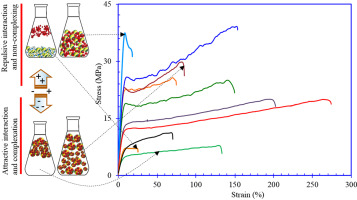当前位置:
X-MOL 学术
›
Food Hydrocoll.
›
论文详情
Our official English website, www.x-mol.net, welcomes your
feedback! (Note: you will need to create a separate account there.)
Solvent strength and biopolymer blending effects on physicochemical properties of zein-chitosan-polyvinyl alcohol composite films
Food Hydrocolloids ( IF 11.0 ) Pub Date : 2019-02-01 , DOI: 10.1016/j.foodhyd.2018.08.006 Stephen Gitonga Giteru , M. Azam Ali , Indrawati Oey
Food Hydrocolloids ( IF 11.0 ) Pub Date : 2019-02-01 , DOI: 10.1016/j.foodhyd.2018.08.006 Stephen Gitonga Giteru , M. Azam Ali , Indrawati Oey

|
Abstract The aim of this research was to optimise and develop edible films made from zein (ZN), chitosan (CS), poly(vinyl alcohol) (PVOH) and poly(ethylene glycol) (PEG400) using Box Behnken Design (BBD). Four factors viz. ZN:CS ratio (w/w) (1:3, 1:1, 3:1), PVOH wt.% (in dry film) (0, 0.25, and 0.5), PEG400 wt% (0.13, 0.21, 0.31) and ethanol (40–80% v/v in water), were investigated. The effects on tensile strength (TS), Young's modulus of elasticity (EM), elongation at break (%EAB), water vapour permeability (WVP), solubility in water (Ws), and optical properties were evaluated. The films were further characterised using differential scanning calorimetry (DSC), thermogravimetric analysis (TGA), scanning electron microscopy (SEM), x-ray diffraction (XRD) and swelling behaviour. SEM micrographs showed that high levels of ZN and PEG400 resulted in rough surfaces with major film defects, but these were minimised at high levels of CS or PVOH. XRD analysis indicated potential interactions through hydrogen bonding between the polar groups of ZN and hydroxyl moieties of PVOH and CS. Stress-strain curves showed that ZN and CS composite films possessed high TS but were brittle. Incorporation of PVOH increased the ductility of the composite films. Optimum films were obtained using ZN/CS/PVOH/PEG400 ratio of 0.35/0.29/0.13/0.23 (wt.%) and 60% ethanol, giving dry state properties of TS, EM, and EAB as 24.21 MPa, 356.62 MPa and 84.23%. respectively. This study demonstrated the influence of critical interactions between solvent features (polarity) and interfacial properties of ZN, CS, PVOH and PEG400. The observed crosslinking behaviour suggested the effectiveness of blending technique in improving the compatibility of biopolymers and overall functionality of edible films.
中文翻译:

溶剂强度和生物聚合物共混对玉米醇溶蛋白-壳聚糖-聚乙烯醇复合膜理化性能的影响
摘要 本研究的目的是使用 Box Behnken Design (BBD) 优化和开发由玉米醇溶蛋白 (ZN)、壳聚糖 (CS)、聚乙烯醇 (PVOH) 和聚乙二醇 (PEG400) 制成的可食用薄膜。四个因素即。ZN:CS 比 (w/w) (1:3, 1:1, 3:1), PVOH wt.% (在干膜中) (0, 0.25, 和 0.5), PEG400 wt% (0.13, 0.21, 0.31 ) 和乙醇(水中 40-80% v/v)进行了研究。评估了对拉伸强度 (TS)、杨氏弹性模量 (EM)、断裂伸长率 (%EAB)、水蒸气渗透率 (WVP)、水中溶解度 (Ws) 和光学性能的影响。使用差示扫描量热法 (DSC)、热重分析 (TGA)、扫描电子显微镜 (SEM)、X 射线衍射 (XRD) 和溶胀行为进一步表征薄膜。SEM 显微照片显示,高含量的 ZN 和 PEG400 会导致粗糙的表面和主要的薄膜缺陷,但这些在高含量的 CS 或 PVOH 下被最小化。XRD 分析表明通过 ZN 的极性基团与 PVOH 和 CS 的羟基部分之间的氢键形成潜在的相互作用。应力-应变曲线表明,ZN 和 CS 复合薄膜具有高 TS 但较脆。PVOH的掺入增加了复合膜的延展性。使用 0.35/0.29/0.13/0.23 (wt.%) 的 ZN/CS/PVOH/PEG400 比例和 60% 乙醇获得最佳薄膜,TS、EM 和 EAB 的干态特性为 24.21 MPa、356.62 MPa 和 84.23 %。分别。该研究证明了溶剂特征(极性)与 ZN、CS、PVOH 和 PEG400 的界面性质之间的关键相互作用的影响。
更新日期:2019-02-01
中文翻译:

溶剂强度和生物聚合物共混对玉米醇溶蛋白-壳聚糖-聚乙烯醇复合膜理化性能的影响
摘要 本研究的目的是使用 Box Behnken Design (BBD) 优化和开发由玉米醇溶蛋白 (ZN)、壳聚糖 (CS)、聚乙烯醇 (PVOH) 和聚乙二醇 (PEG400) 制成的可食用薄膜。四个因素即。ZN:CS 比 (w/w) (1:3, 1:1, 3:1), PVOH wt.% (在干膜中) (0, 0.25, 和 0.5), PEG400 wt% (0.13, 0.21, 0.31 ) 和乙醇(水中 40-80% v/v)进行了研究。评估了对拉伸强度 (TS)、杨氏弹性模量 (EM)、断裂伸长率 (%EAB)、水蒸气渗透率 (WVP)、水中溶解度 (Ws) 和光学性能的影响。使用差示扫描量热法 (DSC)、热重分析 (TGA)、扫描电子显微镜 (SEM)、X 射线衍射 (XRD) 和溶胀行为进一步表征薄膜。SEM 显微照片显示,高含量的 ZN 和 PEG400 会导致粗糙的表面和主要的薄膜缺陷,但这些在高含量的 CS 或 PVOH 下被最小化。XRD 分析表明通过 ZN 的极性基团与 PVOH 和 CS 的羟基部分之间的氢键形成潜在的相互作用。应力-应变曲线表明,ZN 和 CS 复合薄膜具有高 TS 但较脆。PVOH的掺入增加了复合膜的延展性。使用 0.35/0.29/0.13/0.23 (wt.%) 的 ZN/CS/PVOH/PEG400 比例和 60% 乙醇获得最佳薄膜,TS、EM 和 EAB 的干态特性为 24.21 MPa、356.62 MPa 和 84.23 %。分别。该研究证明了溶剂特征(极性)与 ZN、CS、PVOH 和 PEG400 的界面性质之间的关键相互作用的影响。











































 京公网安备 11010802027423号
京公网安备 11010802027423号